羅曼·羅蘭原著《約翰·克利斯朵夫》(傅雷譯)是我初二讀的第一本大河小說。約45年過去,看到《約翰·克利斯朵夫》(濃縮本),梁祥美譯,台北:志文,2004(49幅由 F. 馬塞瑞爾畫的插圖)。
我認識這位木刻名家,去大搜索,發現原插畫竟然有666幅呢。
有些複印1500張..... 我希望有機會找到這附666張木刻的版本!
我認識這位木刻名家,去大搜索,發現原插畫竟然有666幅呢。
有些複印1500張..... 我希望有機會找到這附666張木刻的版本!
30年代中國已出版數本。90年代末。山東畫報社再版。
From Notre Dame de Paris by Victor Hugo. Illustrator: Frans Masereel, 1928.
| 《一個人的受難》序 作者:魯迅 1933年8月6日 |
本篇最初印入一九三三年九月上海良友圖書印刷公司出版的《一個人的受難》。
|
「連環圖畫」這名目,現在已經有些用熟了,無須更改;但其實是應該稱為「連續圖畫」的,因為它並非「如環無端」,而是有起有訖的畫本。中國古來的所謂「長卷」,如《長江無盡圖卷》,如《歸去來辭圖卷》,也就是這一類,不過聯成一幅罷了。
這種畫法的起源真是早得很。埃及石壁所雕名王的功績,「死書」所畫冥中的情形,已就是連環圖畫。別的民族,古今都有,無須細述了。這於觀者很有益,因為一看即可以大概明白當時的若干的情形,不比文辭,非熟習的不能領會。到十九世紀末,西歐的畫家,有許多很喜歡作這一類畫,立一個題,製成畫帖,但並不一定連貫的。用圖畫來敘事,又比較的後起,所作最多的就是麥綏萊勒。我想,這和電影有極大的因緣,因為一面是用圖畫來替文字的故事,同時也是用連續來代活動的電影。
麥綏萊勒(Frans Masereel)是反對歐戰的一人;據他自己說,以一八九九年七月三十一日生於弗蘭兌倫的勃蘭勘培克(Blankenberghe in Flandern),幼小時候是很幸福的,因為玩的多,學的少。求學時代是在干德(Gent),在那裡的藝術學院裏學了小半年;後來就漫遊德,英,瑞士,法國去了,而最愛的是巴黎,稱之為「人生的學校」。在瑞士時,常投畫稿於日報上,摘發社會的隱病,羅曼羅蘭比之於陀密埃(Daumier)和戈耶(Goya)。但所作最多的是木刻的書籍上的插圖,和全用圖畫來表現的故事。他是酷愛巴黎的,所以作品往往浪漫,奇詭,出於人情,因以收得驚異和滑稽的效果。獨有這《一個人的受難》(Die Passion eines Menschen)乃是寫實之作,和別的圖畫故事都不同。
這故事二十五幅中,也並無一字的說明。但我們一看就知道:在桌椅之外,一無所有的屋子裡,一個女子懷著孕了(一),生產之後,即被別人所斥逐,不過我不知道斥逐她的是僱主,還是她的父親(二)。於是她只好在路上彷徨(三),終於跟了別人;先前的孩子,便進了野孩子之群,在街頭搗亂(四)。稍大,去學木匠,但那麼重大的工作,幼童是不勝任的(五),到底免不了被人踢出,像打跑一條野狗一樣(六)。他為飢餓所逼,就去偷麵包(七),而立刻被維持秩序的巡警所捕獲(八),關進監牢裡去了(九)。罰滿釋出(十),這回卻輪到他在熱鬧的路上彷徨(十一),但幸而也竟找得了修路的工作(十二)。不過,終日揮著鶴嘴鋤,是會覺得疲勞的(十三),這時乘機而入的卻是惡友(十四),他受了誘惑,去會妓女(十五),去玩跳舞了(十六)。但歸途中又悔恨起來(十七),決計進廠做工,而且一早就看書自習(十八);在這環境裡,這才遇到了真的相愛的同人(十九)。但勞資兩方衝突了,他登高呼號,聯合下工人,和資本家戰鬥(二十),於是奸細窺探於前(二十一),兵警彈壓於後(二十二),奸細又從中離間,他被捕了(二十三)。在受難的「神之子」耶穌像前,這「人之子」就受著裁判(二十四);自然是死刑,他站著,等候著兵們的開槍(二十五)!耶穌說過,富翁想進天國,比駱駝走過針孔還要難。但說這話的人,自己當時卻受難(Passion)了。現在是歐美的一切富翁,幾乎都是耶穌的信奉者,而受難的就輪到了窮人。這就是《一個人的受難》中所敘述的。
一九三三年八月六日,魯迅記。

圖書
沒有字的故事
Masereel, Frans, 1889-1972.; 麥綏萊勒 (Masereel, Frans, 1889-1972);
2003.
画梦重温
可在 總圖書館 Main Library 總圖2F藝術資料區 (937 4024-1)獲得
館藏已從我的最愛中刪除
2
圖書
麦绥莱勒木刻选
1959.
超星數字圖書館
線上可獲得
館藏已從我的最愛中刪除
3
圖書
麦绥莱勒木刻选集
Masereel, Frans, 1889-1972.
1980.
超星數字圖書館
線上可獲得
館藏已從我的最愛中刪除
圖書
麦绥莱勒黑白木刻
2000.
超星數字圖書館
線上可獲得
館藏已從我的最愛中刪除
一个人的受难
超星數字圖書館
城市 木刻組画
Masereel, Frans, 1889-1972.; 蔔維勤;馬, 克
已找到2個版本. 查看所有版本
7
圖書
魯迅雜文選集
魯迅
2011[民100]
當代文庫. 3.; 名家解讀 著者本名周樟壽,後改名周樹人
The Metropolitan Museum of Art, New York
A librarian in Watson Library highlights one of her favorite artists: Frans Masereel, a Belgian graphic artist who is considered by some to be the creator of the woodcut novel.

Frans Masereel: The First Woodcut Novelist
Associate Museum Librarian Tamara Fultz discusses the gorgeous woodcuts of Frans Masereel
METMUSEUM.ORG
Frans Masereel: The First Woodcut Novelist
August 23, 2017
Tamara Fultz, Associate Museum Librarian, Thomas J. Watson Library
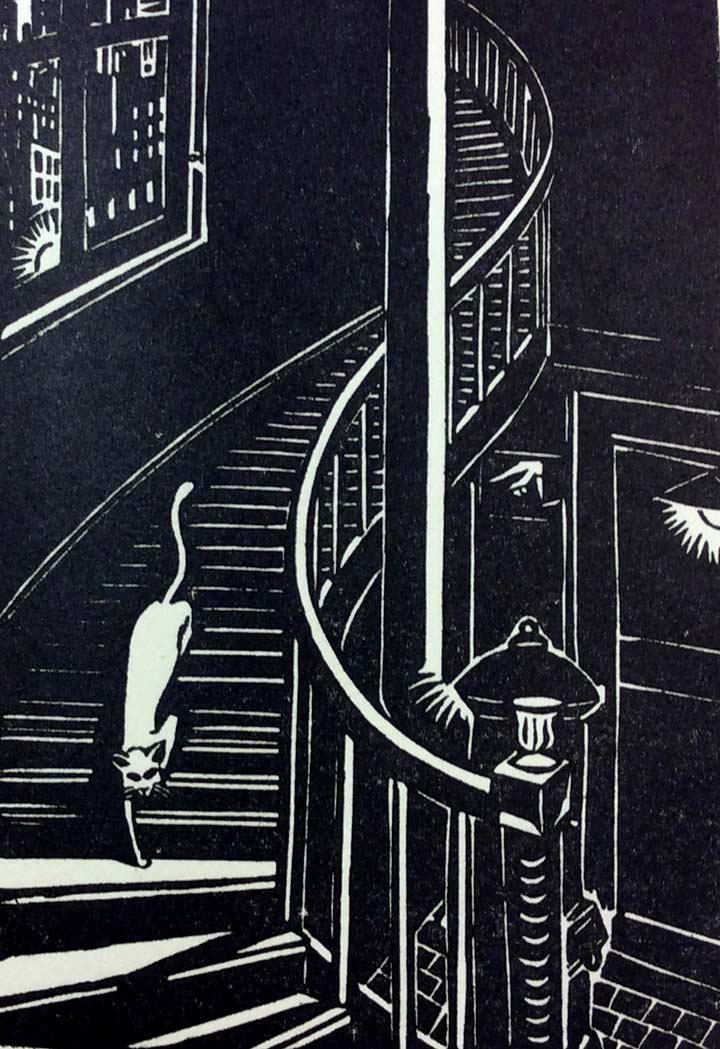
Frans Masereel, Landschaften und Stimmungen: 60 Holzschnitte (Munich: K. Wolff, 1929).
What defines our attraction to a particular artist? Education and experience can offer us opportunities to see an artist's work, but whether we like or truly appreciate it is dependent on individuality and personal taste. In my own work, I get to see a wide variety of art in books—from ancient to contemporary—and there are always some artists that I prefer over others. This post is a reflection on one of my favorites: Frans Masereel (1889–1972).
Masereel, a Belgian graphic artist, is considered by some to be the creator of the woodcut novel. There is a certain warmth and linear clarity to woodcuts that I find appealing: everything from the woodcuts of Albrecht Dürer (1471–1528) to the woodblock prints of Japanese artists in the ukiyo-e style. Masereel's woodcut novels fascinate me because in each one he creates a narrative using strictly images, no text—although there may be an introduction by Thomas Mann or some other great contemporary. For a modern-day equivalent to this kind of work, you might be familiar with the graphic novelist Eric Drooker, whose artwork in Flood! was heavily influenced by the novels of Masereel.
Thomas J. Watson Library has a number of Masereel's woodcut novels. Below are some images that I will let speak for themselves, just as Masereel would have done.
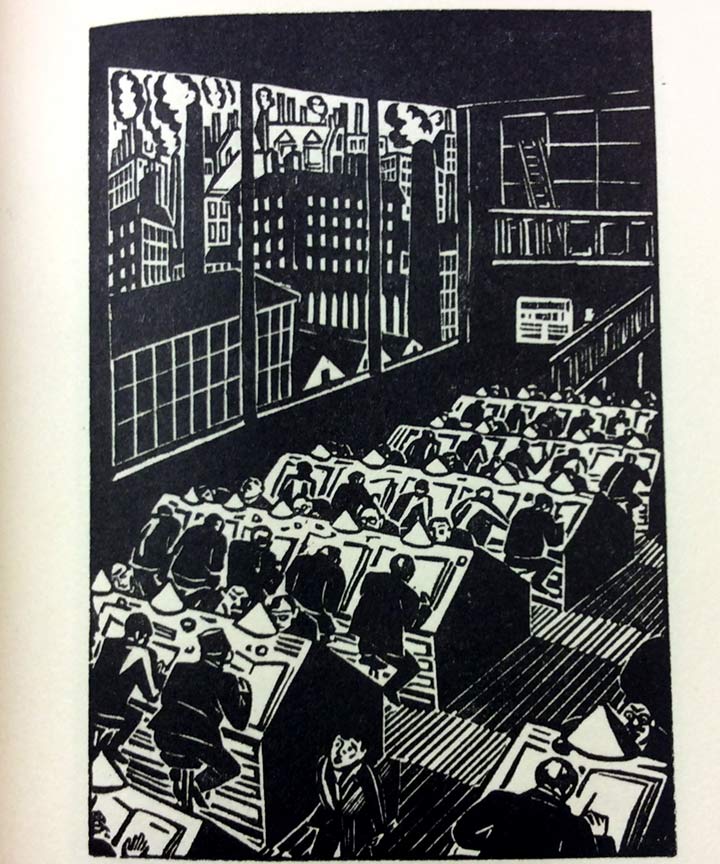
Frans Masereel, Landschaften und Stimmungen: 60 Holzschnitte (Munich: K. Wolff, 1929).
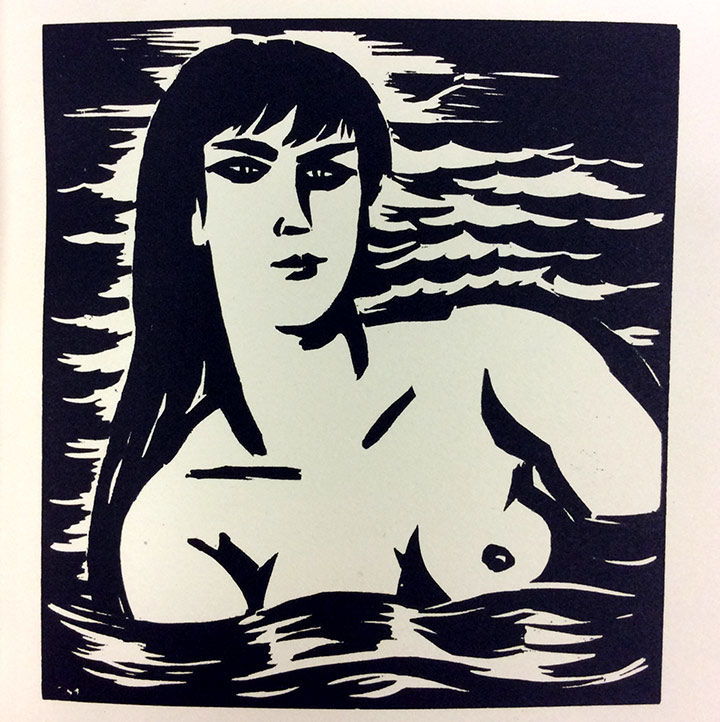
Frans Masereel, La Sirène: Vingt-Huit Bois Gravés (Paris: P. Verms [Coulouma], 1932).
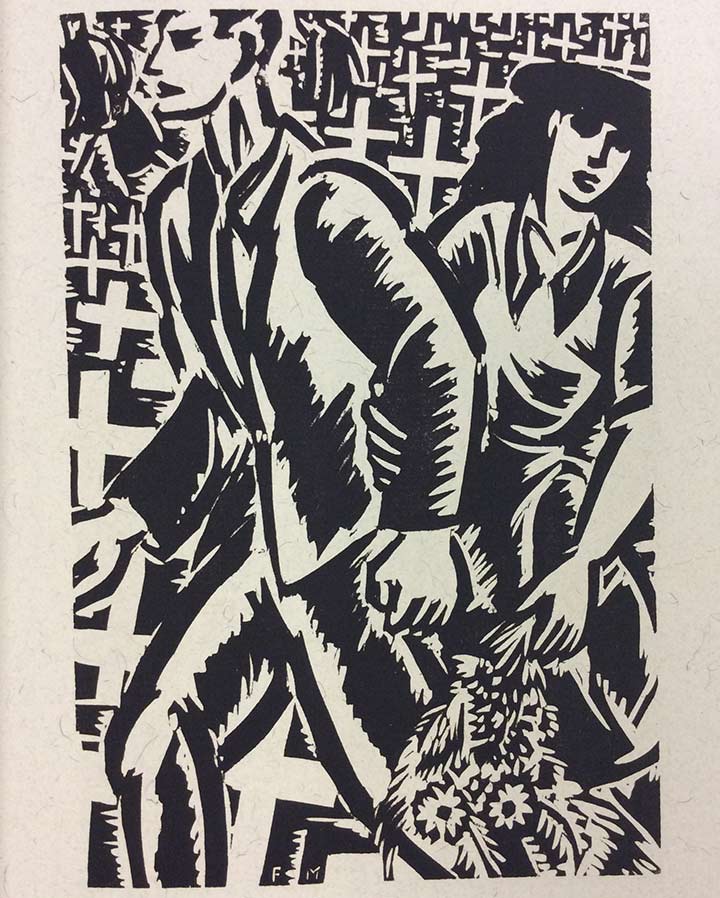
Frans Masereel and Thomas Mann, Jeunesse (Zurich: Oprecht, 1948).
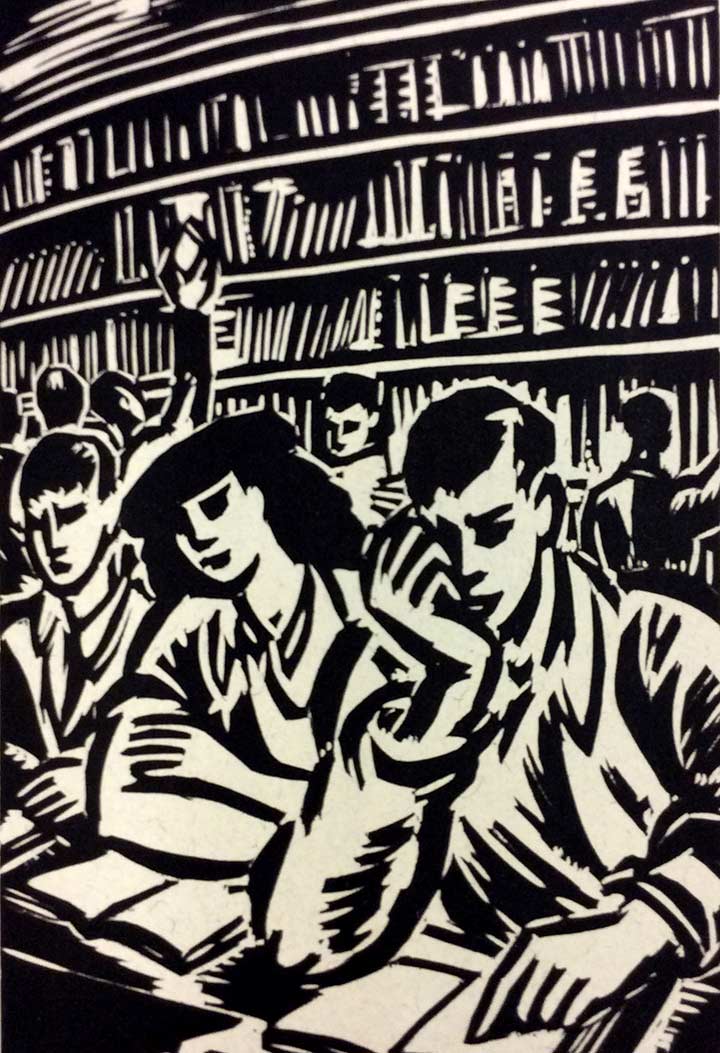
Frans Masereel and Thomas Mann, Jeunesse (Zurich: Oprecht, 1948).
Department: Thomas J. Watson Library
------
布蘭肯貝赫,比利時,1889年 - 法國阿維尼翁,1972年
圖形藝術家,木雕刻師,插畫
工作為報紙和雜誌的插畫,Masereel在1917年遇到了茨威格在瑞士時,他被連同來自歐洲各地的知識分子爭取和平。
“一個堅實的,甜的身影,眼鏡後面的一個嚴重的樣子,像維爾哈倫,只穿著厚衣服燈芯絨,在勞動者的風采。吸引我的是他從第一分鐘......“”奇妙,我特別喜歡他的認真的態度,他聽的方式。沒想到從別人這麼多......“”......安慰[在這些艱難的日子]:那麼清澈,純淨,這樣很好。我知道有我周圍的幾個人,我的愛。他只是善良,能源,最精彩的結合。“
儘管他的堅硬,粗糙的外觀,Masereel是出現在日記中最可愛的人物。他在信Friderike他沒有掩飾他對這場轟轟烈烈的藝術家的感情,滿腦子善良。
Masereel由威爾·艾斯納和藝術斯皮格曼口徑的藝術家們認為通過他的大集合“中篇無字”,和平主義十字軍東征過程中產生的發明了圖形小說。該集團圍繞兩個報紙,德棉,由善變Guilbeaux(共產黨員誰轉化為反共)和La弗耶,其中Masereel發表了關於戰爭的恐怖日常木刻成立走到了一起。
中心人物是羅曼·羅蘭,誰贏得了諾貝爾文學獎於1915年出席會議的還有俄國的革命者,如列寧和托洛茨基,等待沙皇秋天,愛爾蘭人詹姆斯·喬伊斯寫的英文,但強烈的反英的精神,作曲家費魯喬布索尼等等。
羅曼·羅蘭原著《約翰·克利斯朵夫》(傅雷譯)是我初二讀的第一本大河小說。約45年過去,看到《約翰·克利斯朵夫》(濃縮本),梁祥美譯,台北:志文,2004(49幅由 F. 馬塞瑞爾畫的插圖)。
我認識這位木刻名家,去大搜索,發現原插畫竟然有666幅呢。
有些幅印1500張..... 我希望有機會找到這附666張木刻的版本!
Masereel所示的紀念讓·克里斯托夫,由羅蘭,666木刻,也茨威格的中篇小說和平主義者強迫,利用斯特凡和Friderike的數字為型號為兩位主角。有關完整的作品在俄羅斯(1926年)的集合,他創造已被轉載數百次,這一天茨威格的忠實寫照。他還說明其他偉大的作家,如左拉和托馬斯·曼的作品。
在接下來的23年來,他們在巴黎,尼斯,奧斯坦德和薩爾茨堡非常接近,直到1940年時,茨威格離開歐洲去新大陸。甚至一度安全的在大西洋的另一邊,試圖茨威格痴迷於獲得Masereel入境簽證巴西,阿根廷,哥倫比亞和美國。一切都是徒勞:也許是因為他太痛苦和沮喪。
在德國佔領他在小城鎮藏在法國鄉村。他不是猶太人,也不是共產黨,他的社會主義是從羅蘭的沒有什麼不同。他們都沒有被蓋世太保追捕。在茨威格的回憶錄,他在三個場合說過,他的散文首先收集,Begegnungen麻省理工學院Menschen,BüchernUNDStädten[遭遇的人,書籍與城市]茨威格包括一塊約Masereel。
他刻畫在他們的現代文明隔絕的人,而在同一時間提供了行動的可能性。在他的木刻作品的製作,他等系列作為一個男人的激情(1918年)的25張圖片,80工程漢堡和臉部週期的100市(1925年)。從1947年到1951年,他在藝術和工藝的薩爾布呂肯最近創辦學校領導繪畫班。在瑞士,1953年他創辦了Xylon公司 - 木材雕刻的國際協會。第二次世界大戰的結束和1968年間,他發表了一系列代表某一主題的變化版畫。他是眾多展覽的主題和藝術的幾個學院的成員。他的名字出現在機構,如法朗士·麥綏萊勒中心,在卡斯特萊,比利時和Masereelsfonds,促進它最初是關聯到比利時共產黨,這在當今具有獨立進取處置弗拉芒語實體的負責人。
地址上市:30街宮3 Faucons,阿維尼翁。
http://www.casastefanzweig.org.br/agenda_en/s18.html
Blankenberge, Belgium, 1889 — Avignon, France, 1972
Graphic artist, wood engraver, illustrator
Working as an illustrator for newspapers and magazines, Masereel met Stefan Zweig in Switzerland in 1917 when he was fighting for peace together with other intellectuals from all over Europe.
“A solid, sweet figure, a grave look behind the spectacles, like Verhaeren, only wears thick corduroy clothes, in the style of a labourer. I was attracted to him from the first minute...” “Marvellous, I especially like his serious manner and the way he listens. I never expected so much from someone...” “...A comfort [in these difficult days]: so clear, pure, so good. I’m aware that there are few people around me that I love. He is nothing but goodness, energy, the most wonderful combination.”
Notwithstanding his hard, rough appearance, Masereel was the dearest character to appeared in the diaries. In his letters to Friderike he didn’t hide his affection for this vigorous artist, brimming over with goodness.
Masereel is considered by artists of the calibre of Will Eisner and Art Spiegelman to have invented the graphic novel through his large collection of “novellas without words”, produced during the pacifist crusade. The group came together around two newspapers, Demain, founded by the mercurial Guilbeaux (a Communist who converted to anti-Communist) and La Feuille, where Masereel published daily woodcuts about the horrors of war.
The central figure was Romain Rolland, who won the Nobel Prize for Literature in 1915. Also present were Russian revolutionaries such as Lenin and Trotsky, awaiting the fall of the Czar, the Irishman James Joyce writing in English but intensely anti-British in spirit, the composer Ferruccio Busoni and many others.
Masereel illustrated the monumental Jean Christophe, by Rolland, with 666 woodcuts, and also Zweig’s pacifist novella Compulsion, using the figures of Stefan and Friderike as models for the two protagonists. For a collection of complete works in Russian (1926) he created a faithful portrait of Zweig which has been reproduced hundreds of times to this day. He also illustrated the works of other great authors, such as Émile Zola and Thomas Mann.
Over the next 23 years they were very close in Paris, Nice, Ostend and Salzburg, until 1940 when Zweig left Europe for the New World. And even once safe on the other side of the Atlantic, Zweig tried obsessively to obtain for Masereel entry visas for Brazil, Argentina, Colombia and the United States. All in vain: perhaps because he was too anguished and depressed.
During the German occupation he hid in small towns in the French countryside. He wasn’t Jewish, nor a Communist, his socialism was no different from that of Rolland. Neither of them was hounded by the Gestapo. In Zweig’s memoirs he is mentioned on three occasions and in his first collection of essays, Begegnungen mit Menschen, Büchern und Städten [Encounters with People, Books and Cities], Zweig included a piece about Masereel.
He portrayed people in their isolation in modern civilization, while at the same time offering possibilities for action. In his oeuvre of woodcuts he produced series such as 25 Images of a Man’s Passions (1918), the 80 works The Face of Hamburgand the 100 of the cycle The City (1925). From 1947 to 1951, he lead the painting classes at the recently-founded School of Arts and Crafts in Saarbrücken. In Switzerland in 1953 he founded Xylon – International Society of Wood Engravers. Between the end of the Second World War and 1968 he published a series of engravings representing variations on a particular theme. He was the subject of numerous exhibitions and a member of several academies of the arts. His name appears at the head of institutions such as the Frans Masereel Centre, in Kasterlee, Belgium, and Masereelsfonds, an entity promoting the Flemish language which was originally associated to the Belgian Communist Party and which nowadays has an independent progressive disposition.
Address listed: 30 Rue des 3 Faucons, Avignon.


沒有留言:
張貼留言